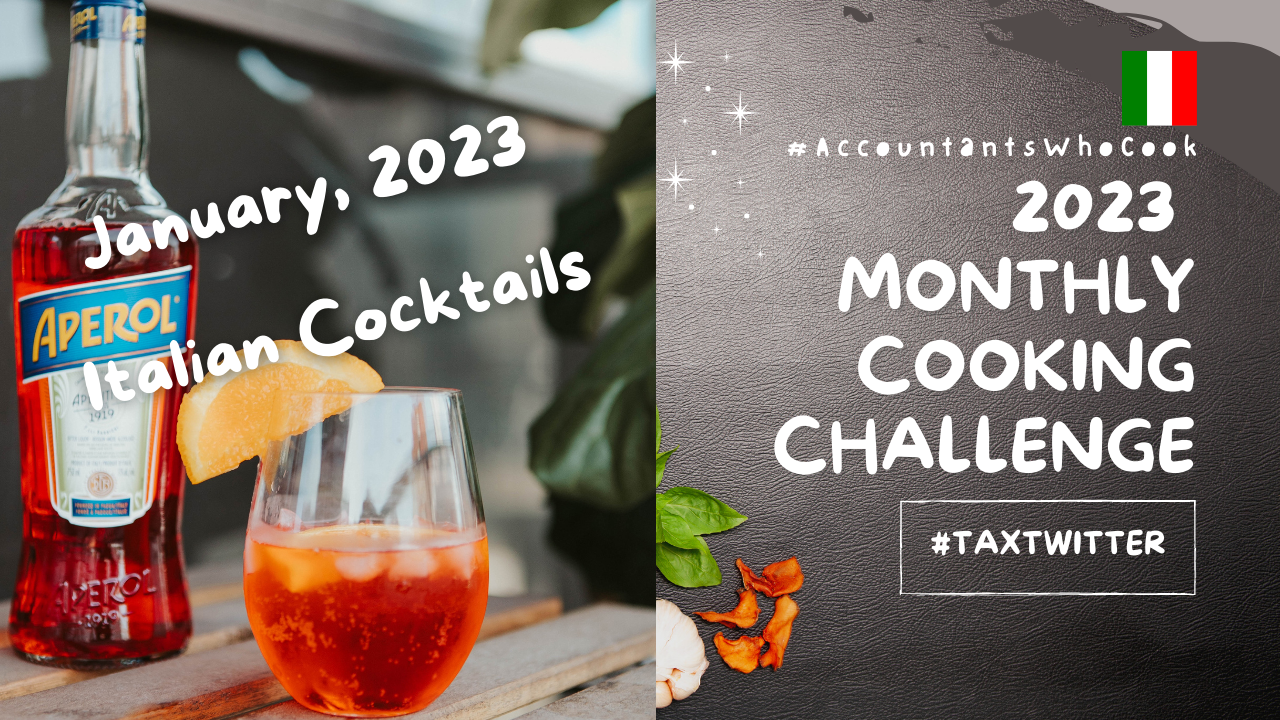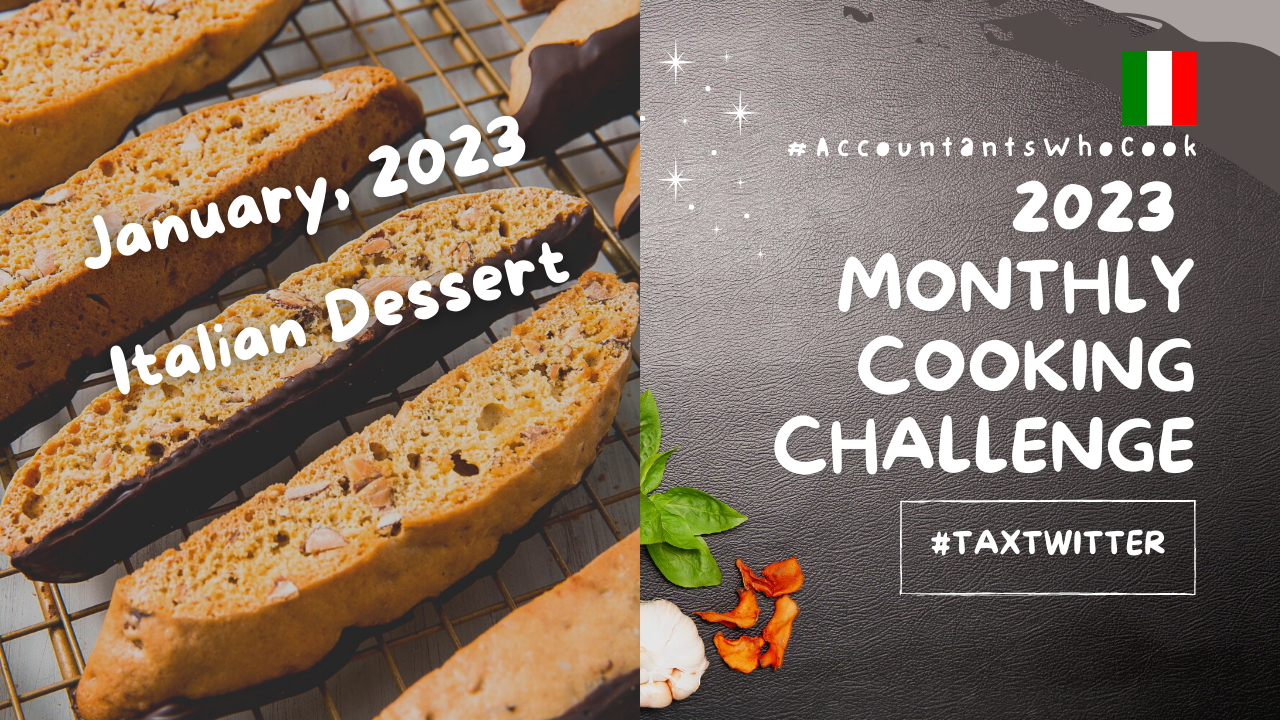Our Cooking Challenge Overview
Dry January is ending, so let’s get wet and explore different Italian cocktails. This is our first month of the 2023 Monthly Cooking Challenge and each week we’re bringing you different recipes to experiment with and learn from. This week we’re focusing on Italian cocktails and adult beverages. You can learn more about the 2023 Cooking Challenge on our introduction post and see other posts related the January theme of Italy here.

Basics of Italian cocktails: Apertivo or digestif
Italians have an alcoholic beverage before and after a meal, and each one has a different purpose. An apertivo is an alcoholic Italian cocktail before a meal to help stimulate the appetite. A digestif is an alcoholic beverage after the meal aids in digestion.
In Italy, this tradition developed around the late 1700’s and continues in various forms around the world today.
Background on the Italian Cocktail: Apertivo
An apertivo in Italy is a tradition dating back to around the late 1700’s. Dinner in Italy usually starts late – around 9:00 pm. If you travel to Italy now, you will see people gathering for drinks and a small appetizer plate before the restaurants open for dinner.
The last time that Katherine was in Florence (Firenze) many restaurants asked if you are looking for dinner or drinks. For dinner, you would be told what time they open, for drinks, you would be allowed into the bar area.
Travel & Leisure had a great writeup on the history of the apertivo and is worth a read:
“Generally, aperitivo drinks are bitter, herbal, and low in alcohol. Vermouth and other wines, including sparklers like increasingly popular prosecco, are frequently ordered. Bitter flavors are thought to stimulate the appetite and light foods create interest or openness for dining, hence the word aperitivo from aperire, Latin for “open.” Villa pointed out that many of the aperitivo snacks are fried or fatty like cheeses, prosciutto, and mortadella, so sparkling wines are ideal palate cleansers.”
https://www.travelandleisure.com/food-drink/cocktails-spirits/history-of-aperitivo
Italian Cocktail Basics: Using Bitters
Most apertivi are made with a type of liqueur called bitters. Italian bitter liqueurs are made with a combination of ingredients including herbs, roots, and fruits. They are known for their bitter and complex flavors.
Popular Italian bitter liqueurs include:
Aperol, which is less bitter than Campari, is made from a secret recipe that includes rhubarb, gentian root, and cinchona bark. It is typically served as an aperitif and is a key ingredient in the popular cocktail, the Aperol Spritz.
Campari, which is known for its deep red color and bitter taste, is made from a secret recipe that includes bitter oranges, rhubarb, and other herbs and fruits. It is typically served as an aperitif and is a key ingredient in the popular cocktail, the Campari Spritz.
Fernet-Branca, which is made with 27 different herbs and spices, and
Amaro, which is a type of liqueur that is flavored with various herbs and spices and is traditionally consumed after a meal to aid digestion.
Italian bitter liqueurs are typically served as aperitifs, before a meal. They can also be mixed with soda water and served over ice with a slice of orange, as in the case of Aperol and Campari Spritz. They can also be used in cocktail recipes as an ingredient. Some of the traditional cocktails are Americano, Negroni, and Boulevardier.
Italian Cocktail: The Spritz
A spritz is a cocktail that originated in Northern Italy, specifically in the Veneto region. It is typically made by mixing a bitter liqueur such as Aperol or Campari with Prosecco and soda water. The drink is typically served in a wine glass with an orange slice as a garnish. The origins of the spritz can be traced back to the 19th century when Austria controlled the region of Veneto, and soldiers stationed there would add a splash of soda water to their wine to make it more refreshing. This practice eventually evolved into the popular cocktail known as the spritz. The Aperol Spritz and Campari Spritz are two of the most popular variations of the spritz cocktail.
Aperol Spritz
The Aperol Spritz was a popular Italian cocktail on the second season of White Lotus on HBO.
Aperol Spritz is a cocktail that originated in Northern Italy, specifically in the Veneto region. It is made by mixing Aperol, a bitter orange liqueur, with Prosecco, a sparkling white wine, and soda water. The drink is typically served in a wine glass with an orange slice as a garnish. The Aperol Spritz became popular in the 1950s and 1960s as a refreshing drink during the hot summer months. It has since gained popularity around the world and is considered a classic cocktail. It is also known as Aperol Spritz Veneziano, Aperol Spritz all’italiana and Spritz Aperol.
The drink was relatively unknown in the USA until the 2010 when people started looking for lower alcohol drinks.
https://www.liquor.com/recipes/aperol-spritz/
Negroni & Americano & Boulevardier
The Negroni is an Italian cocktail that originated in Italy in the early 20th century. The drink was created by bartended Fosco Scarselli at the Caffè Casoni in Florence when regular customer Count Camillo Negroni asked the bartender to make his Americano cocktail stronger by replacing the soda water with gin. The bartender obliged and the Negroni was born. The drink quickly gained popularity and became a classic cocktail.
The Negroni is made by mixing equal parts gin, sweet vermouth, and Campari. It is typically served on the rocks with a twist of orange peel. The cocktail is known for its bitter, complex flavor and is often considered a “grown-up” drink.
The Negroni is considered a classic cocktail, and it has undergone a resurgence in popularity in recent years, with many bartenders and mixologists experimenting with variations and twists on the traditional recipe. Some variations include the Boulevardier (Negroni with bourbon), Old Pal (Negroni with Canadian whisky) and White Negroni (Negroni with gin, Suze and Lillet Blanc)
The Negroni is often considered a timeless classic and has become popular all over the world, enjoyed by many cocktail enthusiasts.
https://www.liquor.com/recipes/negroni/
Here’s the famed Stanley Tucci version:
Limoncello
Limoncello is a traditional Italian liqueur made from the zest of lemons. This liqueur can be used as a cocktail on it’s own or mixed into other Italian cocktails. It is typically made by infusing high-proof alcohol, such as vodka or grain alcohol, with the zest of lemons. Once the lemon zest has infused the alcohol, a simple syrup is added to sweeten the liqueur. The exact origins of limoncello are unknown, but it is believed to have originated in the Amalfi Coast or in Sorrento, Italy.
To make Limoncello, you will need:
- Lemons (around 10-12)
- 1 liter of high-proof alcohol (such as vodka)
- 1 kg of sugar
- 1 liter of water
Instructions:
- Peel the lemons with a potato peeler or a paring knife, making sure to remove only the yellow zest and not the white pith.
- Put the lemon peels in a jar and cover them with alcohol.
- Close the jar and let it infuse for about 10-15 days in a cool, dark place.
- In the meantime, make a simple syrup by dissolving the sugar in water over low heat.
- Once the syrup has cooled, add it to the lemon-alcohol mixture.
- Close the jar and let it infuse for another 10-15 days.
- Strain the limoncello through a fine mesh strainer or a coffee filter and bottle it.
Limoncello is traditionally served chilled, either straight or on the rocks, as a digestif or after dinner drink. It is also used in cocktail recipes as an ingredient or added as a splash to a glass of Prosecco.
Limoncello is also a popular homemade liqueur, and many families in Italy have their own recipe passed down through generations. It is a common sight to see Limoncello being offered in trattorias and osterias in Italy and is increasingly popular worldwide.
Bellini
The Bellini is an Italian cocktail that originated in Harry’s Bar in Venice, Italy in the 1930s. The drink was created by Giuseppe Cipriani, the founder of Harry’s Bar, and was named after the 15th-century Italian painter Giovanni Bellini. The Bellini is made with Prosecco, a dry sparkling wine from the Veneto region of Italy, and white peach puree.
The Bellini is a simple cocktail to make, and it only requires two ingredients: Prosecco and peach puree. The traditional recipe calls for white peach puree, but other types of peach or even other fruits like strawberry, raspberry or mango can be used as well.
To make a Bellini, you will need:
- Prosecco
- Peach puree (around 2-3 ounces)
Instructions:
- Pour the peach puree into a flute glass.
- Slowly pour the Prosecco into the glass, being careful not to disturb the puree.
- Stir gently with a spoon, if necessary, to combine the puree and Prosecco.
The Bellini is typically served chilled and is best enjoyed as an aperitif or a brunch drink. The cocktail is known for its sweet and fruity flavor, and it’s a perfect drink to enjoy on a hot summer day.
The Bellini quickly became popular at Harry’s Bar, and it soon became a favorite among the jet set of the time, including Ernest Hemingway, Orson Welles, and Truman Capote. The Bellini is now a classic cocktail and is enjoyed all over the world, and it’s still a signature drink of Harry’s Bar.
Here’s a video showing three ways to make a Bellini:
Digestif:
There are regional digestifs across Italy. Since Brian’s family comes from Abruzzo, we’ll introduce you to Centerbe.
Centerbe is a traditional Italian liqueur made with a blend of over 70 different herbs and spices. The exact recipe for Centerbe is guarded secret and is known only to a select few.
The origins of Centerbe can be traced back to the Abruzzo region of Italy, where it was first created in the 19th century. The liqueur was said to have been created by a group of monks who used a blend of herbs and spices to create a medicinal tonic.
Centerbe is typically served as a digestif, and it is often consumed neat or on the rocks. It has a strong and distinct flavor, with notes of herbs, spices, and a slight sweetness.
Centerbe is a unique and complex liqueur that is not well known outside of Italy, and it’s not easy to find it abroad. If you ever come across Centerbe, it is worth trying it, to experience its unique and intense flavor. It’s a liqueur that is not for everyone, but those who appreciate its strong and complex taste will appreciate its unique character.
Here are instructions on how to make this digestif.
Keep In Touch
We’d love for you to keep in touch with us. If you haven’t already, please subscribe to our blog or sign up for our newsletter mailing list on our home page.



One response to “January 2023 Cooking Challenge – Cocktails”
[…] January 7, 2023 3:48 pm January 2023 – Italy, Monthly Cooking Challenge This month were focusing on Italy! Appetizer Bruschetta Main CourseItalian Soup DessertItalian Dolce CocktailCocktails […]